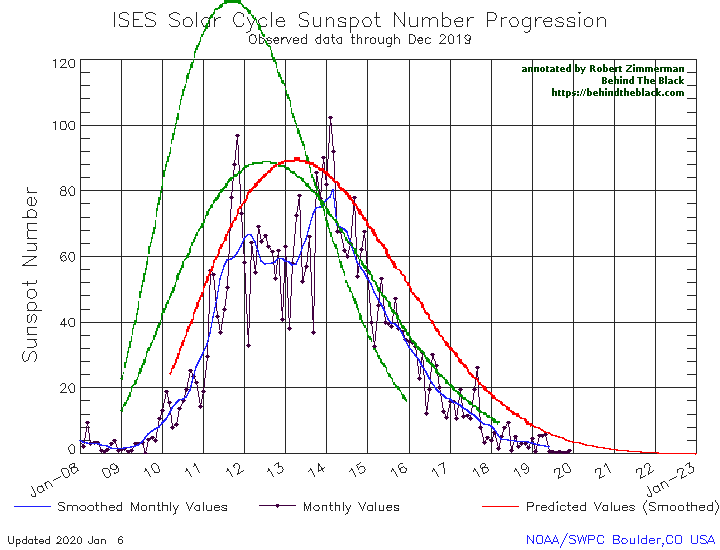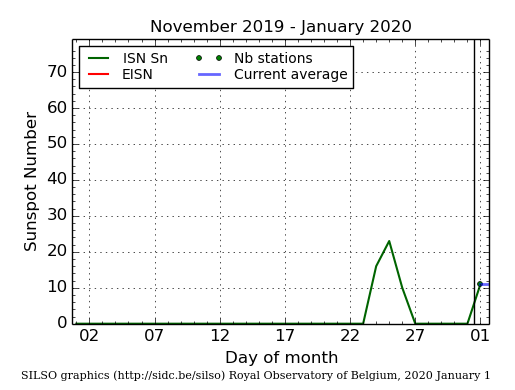Sunspot update: The record flatline continues
In the month of December 2019 the Sun continued its longest stretch of overall sunspot inactivity ever recorded, reaching seven months in length. At no point since the last grand minimum in the 1600s have scientists ever seen so few sunspots over so long a time period.
Below is NOAA’s December update of its graph showing the long term sunspot activity of the Sun. As I have done now every month since this webpage began in 2011, it is posted below, with annotations:

The graph above has been modified to show the predictions of the solar science community for the previous solar maximum. The green curves show the community’s two original predictions from April 2007, with half the scientists predicting a very strong maximum and half predicting a weak one. The red curve is their revised May 2009 prediction, extended in November 2018 four years into the future.

December saw only two sunspots, both becoming active on the same day, December 24. Both also had a polarity belonging to the next solar cycle, providing evidence that we will have another sunspot maximum sometime in the next five years, and that we are not heading to another grand minimum where there are no sunspots for decades.
The SILSO graph to the right gives a close-up look at the month, and provides further evidence that a new solar maximum is coming. Note the new sunspot that appeared on January 1st. That sunspot also has a polarity assigning it to the next solar maximum. While the sunspots in December were weak and decayed quickly, the January sunspot has been stronger, sticking around for at least a week.
Still, in 2019 the facing hemisphere of the Sun was blank 77% of the time, 281 days total, the most since 1913, when the Sun was blank 313 days. Even though the last solar minimum in 2008-2009 was considered unusually long and weak, the minimum now has been far weaker.
The unknowns remain. Though the detection of sunspots assigned to the next solar maximum strongly suggests that a grand minimum is not about to take place, we still might be surprised. When the last grand minimum occurred in the 1600s, the telescope had just been invented, and scientists really did not know what to look for on the Sun. They didn’t even know that there had been a solar cycle up until that century. It could be that new cycle sunspots did occur, and then stopped appearing.
Or not. I am speculating wildly. All we can do is watch and wait to find out.
Meanwhile, the Sun’s influence on climate change remains uncertain. Periods of weak sunspot activity have generally been associated with cold weather, for reasons that are not yet understood. If such things happen again, as appears to been the case with the lack of warming for the past two decades (during this period of weak sunspot cycles), then we might be able to pin down the Sun’s exact contribution in determining the Earth’s climate. And we need to know that exact contribution in order to better model the Earth’s climate. Right now most climate computer models do not do a very good job, and that failure is partly because of a lack of understanding when it comes to the Sun.
On Christmas Eve 1968 three Americans became the first humans to visit another world. What they did to celebrate was unexpected and profound, and will be remembered throughout all human history. Genesis: the Story of Apollo 8, Robert Zimmerman's classic history of humanity's first journey to another world, tells that story, and it is now available as both an ebook and an audiobook, both with a foreword by Valerie Anders and a new introduction by Robert Zimmerman.
The print edition can be purchased at Amazon or from any other book seller. If you want an autographed copy the price is $60 for the hardback and $45 for the paperback, plus $8 shipping for each. Go here for purchasing details. The ebook is available everywhere for $5.99 (before discount) at amazon, or direct from my ebook publisher, ebookit. If you buy it from ebookit you don't support the big tech companies and the author gets a bigger cut much sooner.
The audiobook is also available at all these vendors, and is also free with a 30-day trial membership to Audible.
"Not simply about one mission, [Genesis] is also the history of America's quest for the moon... Zimmerman has done a masterful job of tying disparate events together into a solid account of one of America's greatest human triumphs."--San Antonio Express-News


Dr. Tamitha Skov at spaceweatherwoman.com offers a series of “space weather” podcast classes as well as daily and weekly forecasts. Hers is a website worth visiting.
Very amazing solar stuff.
“that we are not heading to another grand minimum”
Too early to tell. My prediction was that if we were going into a grande minimum, this next cycle maximum would be weaker than #25.
“All we can do is watch and wait to find out”
This is more like it. and yes, the wait game.
We will never know the sun’s contribution due to the politics of this issue, IMHO.
Prof. Valentina Zharkova has done an analysis that appears to track internal solar dynamics very well. Her, and co investigators’, latest analysis has successfully reproduced earlier solar activity ( known from radionuclides from the
increased galactic cosmic ray flux marking solar minima, and decreased radionuclides from maxima).
Her predictive success for recent sunspot numbers beat 178 predictions, and tied with one other.
There are things about the sun, as with everything, that we do not know that we so not know!
If we had spent on solar research what we spent on AGW, maybe we would know much more and could make predictions.
Phill O wrote, “If we had spent on solar research what we spent on AGW, maybe we would know much more and could make predictions.”
How liberal of you, Phill. Throwing money at this scientific problem would almost certainly done little, as the processes involved evolve over many many centuries. What we need is time, and that is something money can’t buy.